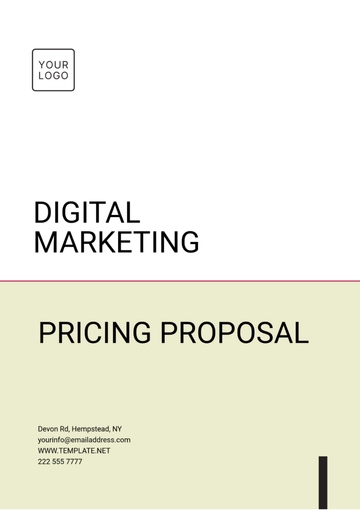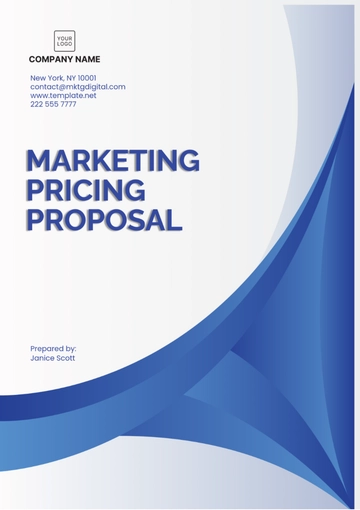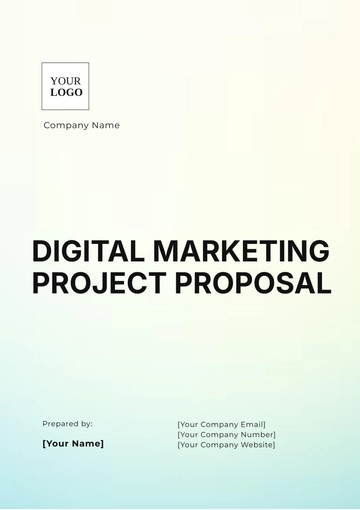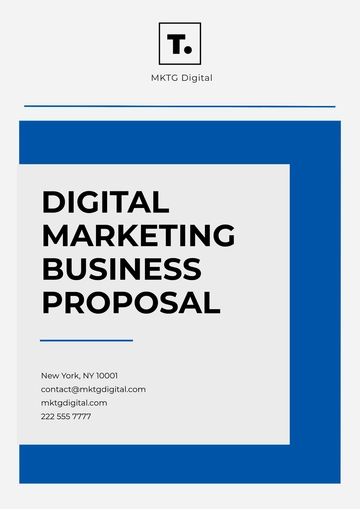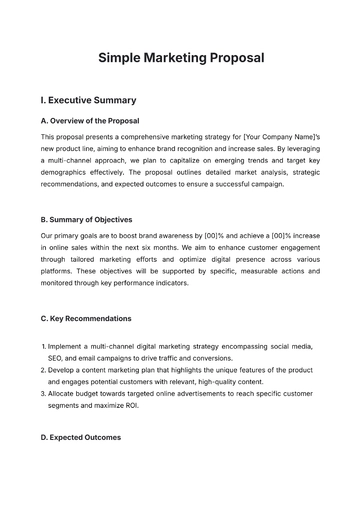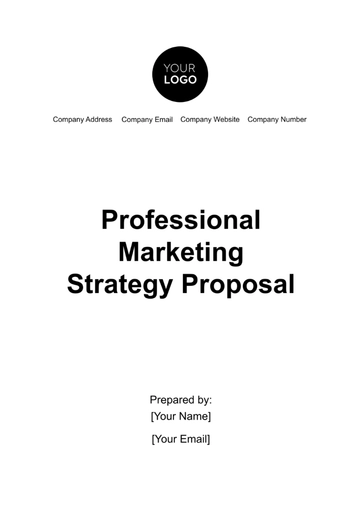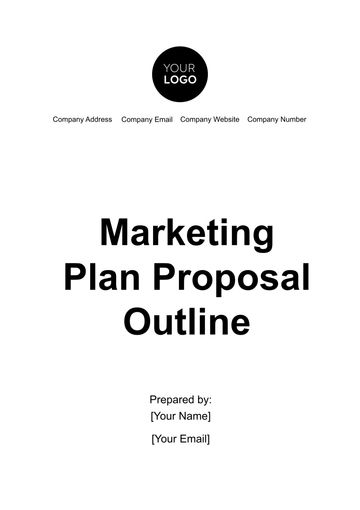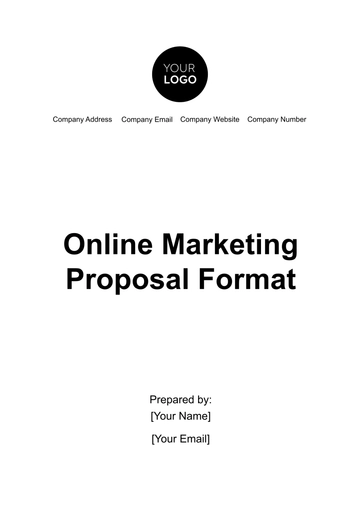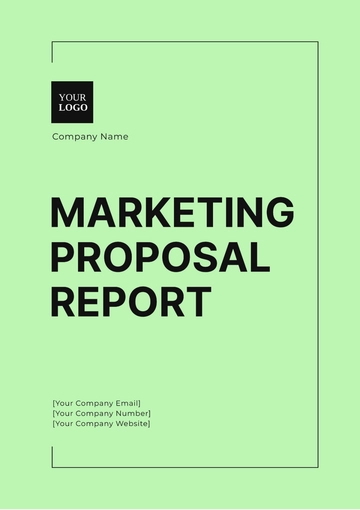Free Agriculture Marketing Proposal
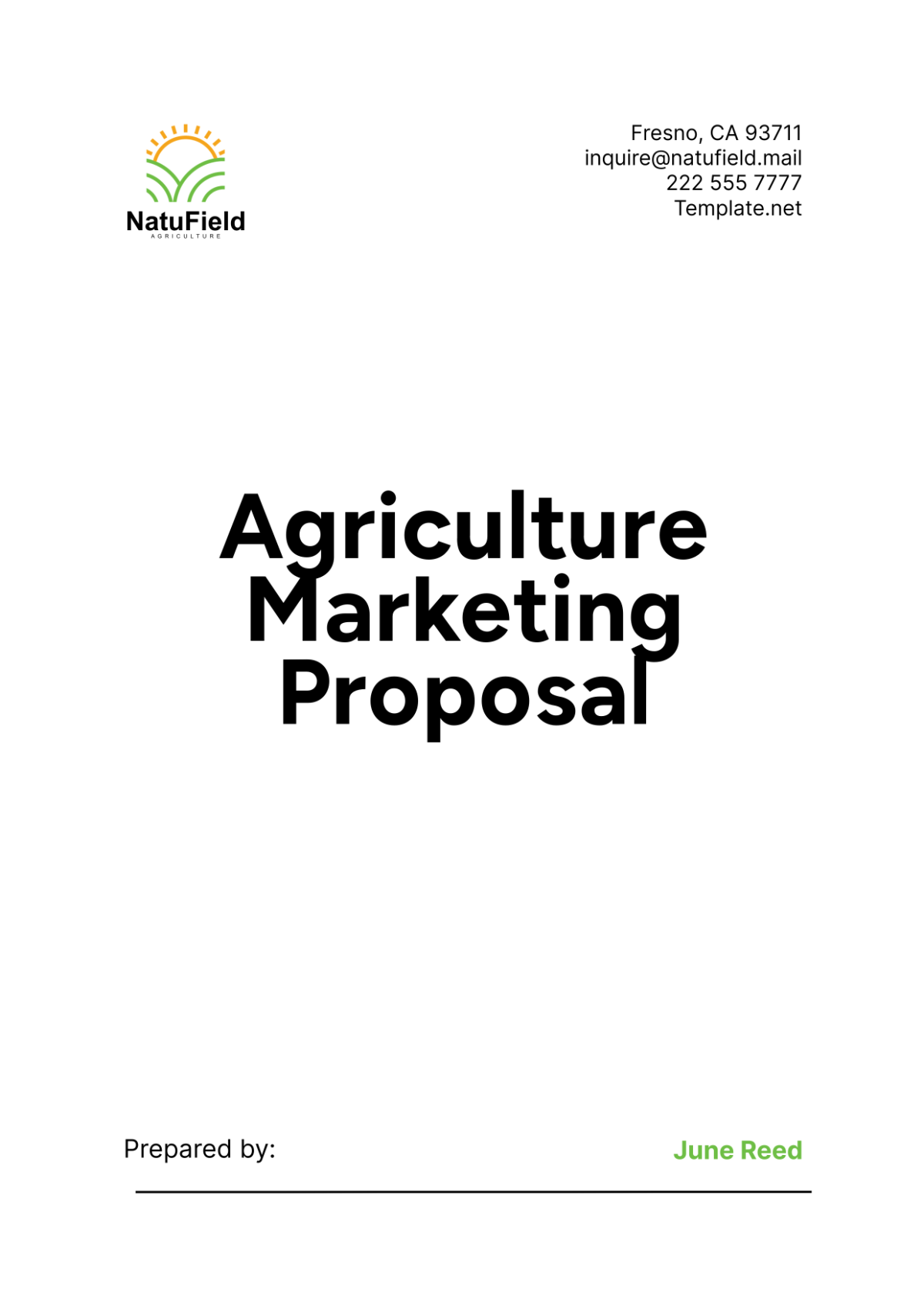
I. Executive Summary
A. Introduction
Agriculture is a cornerstone of the global economy, providing essential food and raw materials for various industries. Despite technological advancements and increased efficiency, the sector faces challenges such as fluctuating market conditions, climate change, and evolving consumer preferences. The purpose of this proposal is to outline a comprehensive marketing strategy for [Your Company Name], aimed at enhancing its presence in the agricultural market. This strategy will drive significant growth in revenue and brand recognition through innovative marketing techniques and a customer-centric approach.
B. Objectives
Increase Market Share: Aim to capture 20% of the local market within the first year. This will involve targeted campaigns, competitive pricing, and strategic partnerships to attract and retain customers.
Brand Awareness: Achieve a 30% increase in brand recognition through targeted marketing campaigns. Utilizing both traditional and digital marketing channels, the objective is to make [Your Company Name] a household name in the agricultural sector.
Sales Growth: Boost sales by 25% within the next 12 months. This will be driven by expanding the product portfolio, optimizing pricing strategies, and enhancing distribution networks to ensure product availability.
Customer Engagement: Enhance customer engagement by 40% through interactive and informative content. By leveraging social media, community events, and educational resources, the goal is to build strong relationships with customers.
C. Scope
This proposal covers a comprehensive analysis of the market, identification of the target audience, detailed marketing strategies, budget allocation, and expected outcomes. The document is designed to provide a clear roadmap for achieving the outlined objectives within a specified timeframe, ensuring that all aspects of the marketing strategy are thoroughly planned and executed.
II. Market Analysis
A. Industry Overview
Global Agriculture Market: The global agriculture market was valued at $9 trillion in 2049, reflecting the sector's immense importance to the global economy. With a projected growth rate of 3.5% annually, the market is expected to reach $12.3 trillion by 2054, driven by increasing demand for food and raw materials.
Technological Advancements: Innovations such as precision farming, drone technology, and genetically modified crops are transforming the agriculture industry. These advancements are enabling farmers to optimize yields, reduce waste, and enhance sustainability, thereby addressing some of the critical challenges faced by the sector.
Sustainability Trends: There is a growing emphasis on sustainable farming practices, organic produce, and eco-friendly products. Consumers are increasingly aware of the environmental impact of their choices and are demanding products that are produced responsibly. This trend is shaping the future of agriculture and creating new opportunities for businesses that prioritize sustainability.
B. Market Trends
Consumer Preferences: There is an increasing demand for organic and locally sourced products. Consumers are becoming more health-conscious and environmentally aware, leading to a preference for products that are perceived as healthier and more sustainable.
Digital Transformation: The adoption of digital tools for farm management and e-commerce platforms for direct sales is revolutionizing the agriculture sector. Farmers are using data analytics, IoT devices, and automation to enhance productivity and reduce costs.
Policy Changes: Government policies are increasingly favoring sustainable practices and providing subsidies for modern farming equipment. These policies are aimed at promoting food security, environmental conservation, and economic growth in rural areas.
C. Competitive Landscape
Major Competitors: Key players in the agricultural market include AgriCorp, GreenFields, and FarmFresh. These companies have established strong brand identities and extensive distribution networks.
Market Positioning: [Your Company Name] is positioned as a provider of high-quality, innovative agricultural products. The company's commitment to sustainability, technological innovation, and customer satisfaction differentiates it from competitors.
SWOT Analysis:
Strengths: Strong R&D capabilities, established brand reputation, and extensive distribution network. These strengths provide a solid foundation for growth and competitive advantage.
Weaknesses: Limited presence in emerging markets and higher product prices compared to competitors. Addressing these weaknesses will be crucial for expanding market reach and improving competitiveness.
Opportunities: Expanding into new markets, forming partnerships with technology firms, and increasing the product portfolio. These opportunities align with market trends and consumer demands.
Threats: Intense competition, fluctuating commodity prices, and changing regulatory environment. These threats require proactive risk management and strategic planning.
D. Target Audience
Primary Audience: Farmers and agricultural businesses. These customers are looking for reliable, cost-effective solutions to enhance productivity and profitability.
Secondary Audience: Distributors, retailers, and consumers interested in organic and sustainable products. Engaging this audience will involve highlighting the benefits and values associated with [Your Company Name]'s products.
Demographic Profile:
Age: 30-60 years
Income: $50,000 - $200,000 annually
Location: Rural and semi-urban areas
Education: High school diploma and above. This demographic is knowledgeable about farming practices and open to adopting new technologies.
III. Marketing Strategies
A. Product Strategy
Product Diversification: Introduce a range of products including organic fertilizers, eco-friendly pest control solutions, and advanced farming equipment. This diversification will cater to various customer needs and preferences, enhancing market reach.
Quality Assurance: Implement stringent quality control measures to ensure product reliability and effectiveness. By maintaining high standards, [Your Company Name] can build trust and loyalty among customers.
Packaging and Labeling: Use eco-friendly packaging materials and provide detailed product information on labels. Clear labeling will help consumers make informed decisions and reinforce the brand's commitment to sustainability.
B. Pricing Strategy
Competitive Pricing: Set prices competitively to attract cost-conscious farmers while ensuring profitability. A balanced pricing strategy will help penetrate the market and establish a strong presence.
Discount Programs: Offer seasonal discounts, bulk purchase incentives, and loyalty rewards. These programs will encourage repeat purchases and build long-term customer relationships.
Flexible Payment Options: Provide financing options and installment plans to ease the financial burden on farmers. By offering flexible payment terms, [Your Company Name] can make its products more accessible to a broader audience.
C. Distribution Strategy
Distribution Channels: Utilize a mix of direct sales, distributors, and e-commerce platforms. This multi-channel approach will ensure that products are available to customers through their preferred purchasing methods.
Geographical Coverage: Expand distribution to underserved rural areas. By reaching out to remote regions, [Your Company Name] can tap into new markets and increase market share.
Logistics and Supply Chain Management: Optimize logistics to ensure timely delivery and reduce transportation costs. Efficient supply chain management will enhance customer satisfaction and operational efficiency.
D. Promotion Strategy
Advertising Campaigns: Launch multi-channel advertising campaigns across TV, radio, print, and online media. These campaigns will raise awareness and highlight the unique benefits of [Your Company Name]'s products.
Social Media Marketing: Leverage platforms like Facebook, Instagram, and YouTube to reach a broader audience. Social media will be used to engage with customers, share educational content, and promote special offers.
Content Marketing: Develop informative blogs, videos, and newsletters to educate customers about sustainable farming practices and product benefits. Content marketing will position [Your Company Name] as a thought leader in the agriculture sector.
E. Public Relations Strategy
Community Engagement: Participate in local agricultural fairs, workshops, and community events. These activities will help build relationships with local farmers and stakeholders.
Partnerships: Collaborate with agricultural universities, research institutions, and NGOs. Partnerships will enhance the company's credibility and expand its reach.
Media Relations: Maintain positive relationships with industry journalists and influencers. Effective media relations will ensure positive coverage and enhance brand image.
IV. Budget Allocation
A. Budget Overview
Total Budget: Allocate a total marketing budget of $5 million for the first year. This budget will be strategically distributed across various marketing activities to maximize impact.
Category-wise Allocation:
Advertising: $2 million
Social Media: $500,000
Content Marketing: $300,000
Public Relations: $200,000
Distribution: $1 million
Miscellaneous: $1 million
B. Detailed Budget Breakdown
Category | Allocation ($) | Percentage (%) |
|---|---|---|
Advertising | 2,000,000 | 40 |
Social Media | 500,000 | 10 |
Content Marketing | 300,000 | 6 |
Public Relations | 200,000 | 4 |
Distribution | 1,000,000 | 20 |
Miscellaneous | 1,000,000 | 20 |
Total | 5,000,000 | 100 |
C. Justification of Budget
Advertising: Essential for creating brand awareness and reaching a wide audience. Investing in advertising will ensure that the brand message is communicated effectively across multiple channels.
Social Media: Cost-effective way to engage with customers and promote products. Social media platforms offer targeted advertising options and the ability to interact directly with customers.
Content Marketing: Builds credibility and educates customers about sustainable practices. High-quality content will attract and retain customers,enhancing their understanding of [Your Company Name]'s products and their benefits.
Public Relations: Enhances brand image and fosters community relationships. Public relations activities will strengthen [Your Company Name]'s reputation and build trust among stakeholders.
Distribution: Ensures products are available in key markets and reduces delivery times. Investing in distribution will optimize logistics and improve customer satisfaction.
Miscellaneous: Reserved for unforeseen expenses and contingency planning. Having a miscellaneous budget allows [Your Company Name] to adapt to changing market conditions and seize unexpected opportunities.
V. Expected Outcomes
A. Revenue Projections
Year 1: Projected revenue of $15 million, driven by increased market share and sales growth initiatives.
Year 2: Aim to achieve $20 million in revenue through sustained marketing efforts and expanded product offerings.
Year 3: Targeting $25 million in revenue, leveraging brand recognition and customer loyalty to drive continued growth.
B. Market Share
Initial Market Share: Aim to capture 10% of the local market in the first year, gradually increasing to 20% by the end of Year 3. This growth will be supported by strategic marketing campaigns and competitive pricing strategies.
Target Market Share: Establish [Your Company Name] as a market leader in sustainable agricultural products, positioning the brand as the preferred choice among farmers and distributors.
C. Brand Recognition
Current Awareness Level: Approximately 50% of the target audience is aware of [Your Company Name]. The goal is to increase this awareness to 80% within the first year through targeted advertising, social media campaigns, and public relations activities.
Target Awareness Level: Establish [Your Company Name] as a trusted brand synonymous with quality, innovation, and sustainability in the agriculture sector. Enhanced brand recognition will drive customer acquisition and loyalty.
D. Customer Engagement
Current Engagement Level: Customer engagement metrics indicate a 30% interaction rate across digital platforms and customer feedback channels.
Target Engagement Level: Increase customer engagement to 70% within the first year, achieved through personalized marketing communications, interactive content, and customer support initiatives. Building strong relationships with customers will foster loyalty and advocacy.
E. Customer Satisfaction
Initial Satisfaction Level: Customer satisfaction surveys indicate a baseline satisfaction rate of 60%. The objective is to improve satisfaction levels to 90% within the first year by delivering exceptional products, services, and support.
Target Satisfaction Level: Implementing feedback-driven improvements and maintaining high product standards will ensure [Your Company Name] exceeds customer expectations and maintains high satisfaction levels.
VI. Implementation Plan
A. Timeline
Q1: Conduct market research, finalize product development, and prepare marketing strategies.
Q2: Launch advertising campaigns, initiate social media marketing, and roll out initial product offerings.
Q3: Expand distribution channels, participate in community events, and enhance public relations activities.
Q4: Evaluate campaign performance, analyze customer feedback, and adjust strategies for Year 2 planning.
B. Key Milestones
Product Launch: Introduce new products and innovations by the end of Q1, focusing on meeting market demands and customer needs.
Advertising Campaign Kickoff: Launch major advertising campaigns across selected media channels in Q2, emphasizing [Your Company Name]'s unique value proposition and benefits.
Distribution Network Expansion: Strengthen distribution networks and partnerships to ensure nationwide coverage by Q3, facilitating easier access to [Your Company Name]'s products.
Performance Review: Conduct quarterly performance reviews, assessing key metrics such as sales growth, market share, and customer satisfaction to guide strategic adjustments and improvements.
C. Responsibility Matrix
Task | Responsible Team | Timeline |
|---|---|---|
Market Research | Marketing Team | Q1 |
Product Development | R&D Team | Q1 |
Campaign Planning | Marketing Team | Q1-Q2 |
Advertising Campaigns | Marketing Team | Q2-Q3 |
Social Media Management | Digital Team | Q2-Q4 |
Content Creation | Content Team | Q2-Q4 |
Distribution Network Expansion | Sales and Logistics | Q3 |
Community Engagement | PR Team | Q3-Q4 |
Performance Review | All Teams | Q4 |
VII. Risk Management
A. Potential Risks
Market Volatility: Fluctuations in commodity prices could impact product pricing and profitability.
Regulatory Changes: New regulations or policy shifts may require adjustments to product formulations or compliance measures.
Competitive Pressure: Intensified competition from established players or new market entrants could challenge market share and pricing strategies.
B. Mitigation Strategies
Market Volatility: Diversify sourcing strategies and implement hedging mechanisms to mitigate risks associated with price fluctuations.
Regulatory Changes: Maintain proactive communication with regulatory bodies, stay updated on industry trends, and adapt quickly to regulatory shifts.
Competitive Pressure: Differentiate [Your Company Name]'s products through innovation, quality assurance, and personalized customer experiences to build brand loyalty and competitive advantage.
C. Contingency Plan
Alternative Suppliers: Identify and qualify alternative suppliers to ensure continuity of supply chain operations.
Crisis Management Team: Establish a dedicated crisis management team to respond promptly to unforeseen events or emergencies.
Financial Reserves: Maintain a contingency fund to address unexpected expenses or capitalize on emergent opportunities without disrupting ongoing operations.
VIII. Conclusion
A. Summary of Proposal
This comprehensive marketing proposal for [Your Company Name] outlines a strategic roadmap to strengthen the company's position in the agricultural market. By leveraging market insights, innovative products, and robust marketing strategies, [Your Company Name] aims to achieve significant growth in revenue, market share, and brand recognition. The proposal underscores the importance of customer-centric approaches, sustainability, and proactive risk management in achieving long-term success in the dynamic agriculture sector.
B. Call to Action
We urge stakeholders to approve this proposal and allocate resources for its implementation. By investing in [Your Company Name]'s marketing initiatives, stakeholders will support the company's mission to deliver value-added solutions to farmers, distributors, and consumers alike. Together, we can seize opportunities, mitigate risks, and achieve sustainable growth in the agriculture market.
C. Next Steps
Approval: Seek approval from senior management and key stakeholders to proceed with the proposed marketing strategy.
Resource Allocation: Allocate the budget and assign responsibilities to respective teams for execution.
Implementation: Initiate the implementation of marketing strategies as per the outlined timeline and milestones.
Monitoring and Evaluation: Continuously monitor performance metrics, gather feedback, and make data-driven adjustments to optimize outcomes and ensure alignment with strategic objectives.
- 100% Customizable, free editor
- Access 1 Million+ Templates, photo’s & graphics
- Download or share as a template
- Click and replace photos, graphics, text, backgrounds
- Resize, crop, AI write & more
- Access advanced editor
Present marketing initiatives with the Agriculture Marketing Proposal Template from Template.net. This editable tool outlines strategies. Use our Ai Editor Tool to craft persuasive proposals, attracting stakeholders and driving market expansion in agricultural sectors.
You may also like
- Business Proposal
- Research Proposal
- Proposal Request
- Project Proposal
- Grant Proposal
- Photography Proposal
- Job Proposal
- Budget Proposal
- Marketing Proposal
- Branding Proposal
- Advertising Proposal
- Sales Proposal
- Startup Proposal
- Event Proposal
- Creative Proposal
- Restaurant Proposal
- Blank Proposal
- One Page Proposal
- Proposal Report
- IT Proposal
- Non Profit Proposal
- Training Proposal
- Construction Proposal
- School Proposal
- Cleaning Proposal
- Contract Proposal
- HR Proposal
- Travel Agency Proposal
- Small Business Proposal
- Investment Proposal
- Bid Proposal
- Retail Business Proposal
- Sponsorship Proposal
- Academic Proposal
- Partnership Proposal
- Work Proposal
- Agency Proposal
- University Proposal
- Accounting Proposal
- Real Estate Proposal
- Hotel Proposal
- Product Proposal
- Advertising Agency Proposal
- Development Proposal
- Loan Proposal
- Website Proposal
- Nursing Home Proposal
- Financial Proposal
- Salon Proposal
- Freelancer Proposal
- Funding Proposal
- Work from Home Proposal
- Company Proposal
- Consulting Proposal
- Educational Proposal
- Construction Bid Proposal
- Interior Design Proposal
- New Product Proposal
- Sports Proposal
- Corporate Proposal
- Food Proposal
- Property Proposal
- Maintenance Proposal
- Purchase Proposal
- Rental Proposal
- Recruitment Proposal
- Social Media Proposal
- Travel Proposal
- Trip Proposal
- Software Proposal
- Conference Proposal
- Graphic Design Proposal
- Law Firm Proposal
- Medical Proposal
- Music Proposal
- Pricing Proposal
- SEO Proposal
- Strategy Proposal
- Technical Proposal
- Coaching Proposal
- Ecommerce Proposal
- Fundraising Proposal
- Landscaping Proposal
- Charity Proposal
- Contractor Proposal
- Exhibition Proposal
- Art Proposal
- Mobile Proposal
- Equipment Proposal
- Student Proposal
- Engineering Proposal
- Business Proposal









